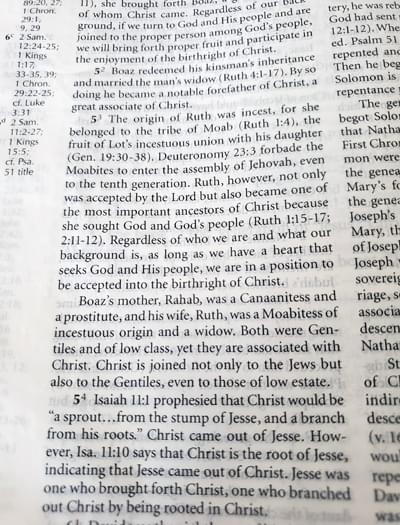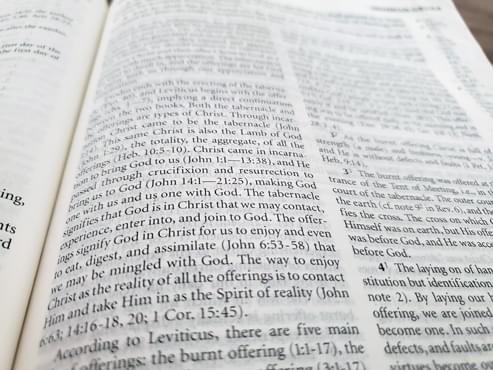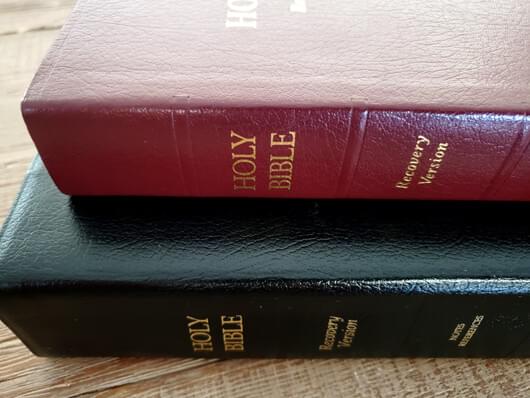The first purpose of the footnotes is to present to you the truth, and the second purpose is to minister to you the life supply. Many of you can testify that you do not get as much nourishment from other expositions and commentaries as you do from the Recovery Version. (Elders’ Training, Book 3: The Way to Carry Out the Vision, ch. 9 [CWWL, 1984 2:310])
The second purpose of the Recovery Version with the footnotes—to minister the life supply—receives the least amount of development among the four purposes identified in the message quoted above. Perhaps this is fitting, for it almost goes without saying. We who have used the Recovery Version can surely testify that it not only teaches the divine truth; it also ministers the Spirit of reality to usher us into all the reality of this truth. Many of the footnotes in the Recovery Version were composed in conjunction with Brother Lee’s semiannual trainings to expound the books of the Bible, and he called this exposition of the Bible a Life-study of the Bible. One of the most distinctive features of the Recovery Version among all the study Bibles currently available is that it ministers the life supply and has this ministry as one of its chief aims.

“...the footnotes themselves supply life to those who read them with a turned heart and an open spirit.”
To say that the footnotes in the Recovery Version minister the life supply is not simply to say that they expound the particular truth concerning the divine life or even that they expound all the truths as they relate to this life (though they certainly do both of these and do them well!). To say that they minister the life supply is to say, in addition, that the footnotes themselves supply life to those who read them with a turned heart and an open spirit. Those of us who have benefited from the Recovery Version can testify that whenever we spend time in it, we come away not only enlightened but also enlivened. We come away not only with new revelation and vision but also with new supply to live the Christian life for the church life.
To illustrate this purpose with some concrete examples, consider the footnotes in two chapters of the Bible that many might not consider prime candidates for ministering the life supply—the first chapter of the Gospel of Matthew and the first chapter of the book of Leviticus.
The Gospel of Matthew begins with a lengthy genealogy of forty-two generations. Some might be tempted to skip over all these names, but the footnotes in the Recovery Version turn this genealogy into a rich ministry of the life supply. Drawing on the fact that both Gentile and sinful women are included in the genealogy, one footnote says, “Regardless of who we are and what our background is, as long as we have a heart that seeks God and His people, we are in a position to be accepted into the birthright of Christ” (note 3 on Matt. 1:5). Drawing on the genealogy’s reference to David’s sin, another says, “When David committed murder and adultery, he was rebuked by the prophet Nathan, whom God had sent purposely to condemn him (2 Sam. 12:1-12). When David was condemned, he repented. Psalm 51 is the record of his repentance. He repented and God forgave him (2 Sam. 12:13). Then he begot Solomon (2 Sam. 12:24). Hence, Solomon is the issue of man’s transgression and repentance plus God’s forgiveness” (note 3 on Matt. 1:6). Summing up the whole genealogy, another says, “Luke’s record begins with Jesus and traces back to God. Matthew’s record proceeds from Abraham to Christ. Luke goes back and up to God; Matthew comes forward and down to Christ. All the generations were directed to Christ and brought in Christ. Christ is the goal, the consummation, the conclusion, the completion, and the perfection of all the generations; as such, He fulfills their prophecies, solves their problems, and meets their needs. When Christ comes, light, life, salvation, satisfaction, healing, freedom, rest, comfort, peace, and joy all come with Him. From this point on, the whole New Testament is a full expounding of this wonderful Christ, who is everything to us. Hallelujah, Christ has come!” (note 4 on Matt. 1:17). Praise the Lord for such a Christ! And praise the Lord that we all, no matter who we are or what we have done, can enter into the birthright of Christ to bring forth Christ for the kingdom of God!
Praise the Lord for such a Christ! And praise the Lord that we all, no matter who we are or what we have done, can enter into the birthright of Christ to bring forth Christ for the kingdom of God!

“The footnotes not only identify Christ as the reality of all the offerings; they also tell us how to enjoy Christ as the reality by being identified with Him...”

Turning from the New Testament to the Old Testament, consider the first chapter of Leviticus. Many Christians today struggle with this book, but the footnotes in the Recovery Version afford a rich and abundant life supply even here. One of the early footnotes identifies Christ as the reality of all the offerings in this book: “The offerings signify God in Christ for us to enjoy and even to eat, digest, and assimilate (John 6:53-58) that we may be mingled with God. The way to enjoy Christ as the reality of all the offerings is to contact Him and take Him in as the Spirit of reality (John 6:63; 14:16-18, 20; 1 Cor. 15:45)” (note 1 on Lev. 1:2). The footnotes not only identify Christ as the reality of all the offerings; they also tell us how to enjoy Christ as the reality by being identified with Him: “The laying on of hands signifies not substitution but identification, union (Acts 13:3 and note 2). By laying our hands on Christ as our offering, we are joined to Him, and He and we become one. In such a union all our weaknesses, defects, and faults are taken on by Him, and all His virtues become ours. This requires us to exercise our spirit through the proper prayer so that we may be one with Him in an experiential way (cf. 1 Cor. 6:17 and notes). When we lay our hands on Christ through prayer, the life-giving Spirit, who is the very Christ on whom we lay our hands (1 Cor. 15:45; 2 Cor. 3:6, 17), will immediately move and work within us to live in us a life that is a repetition of the life that Christ lived on earth, the life of the burnt offering” (note 1 on Lev. 1:4). How marvelous! The book of Leviticus is not merely a book about God’s dealings with the children of Israel several millennia ago; it is a book about Christ as the reality for our living and serving in God’s economy!
We don’t have the space here to further explore the genealogy in Matthew or the sacrifices in the book of Leviticus. But we hope you are as enlivened and supplied as we are by this small taste, and we encourage you to avail yourselves of the rich supply of life in the footnotes on these two chapters!

Living Stream Ministry now has an app for the Recovery Version. View more details about this app or download it from one of the app stores below:
eBooks Available for Purchase:
Print Editions Available for Purchase: